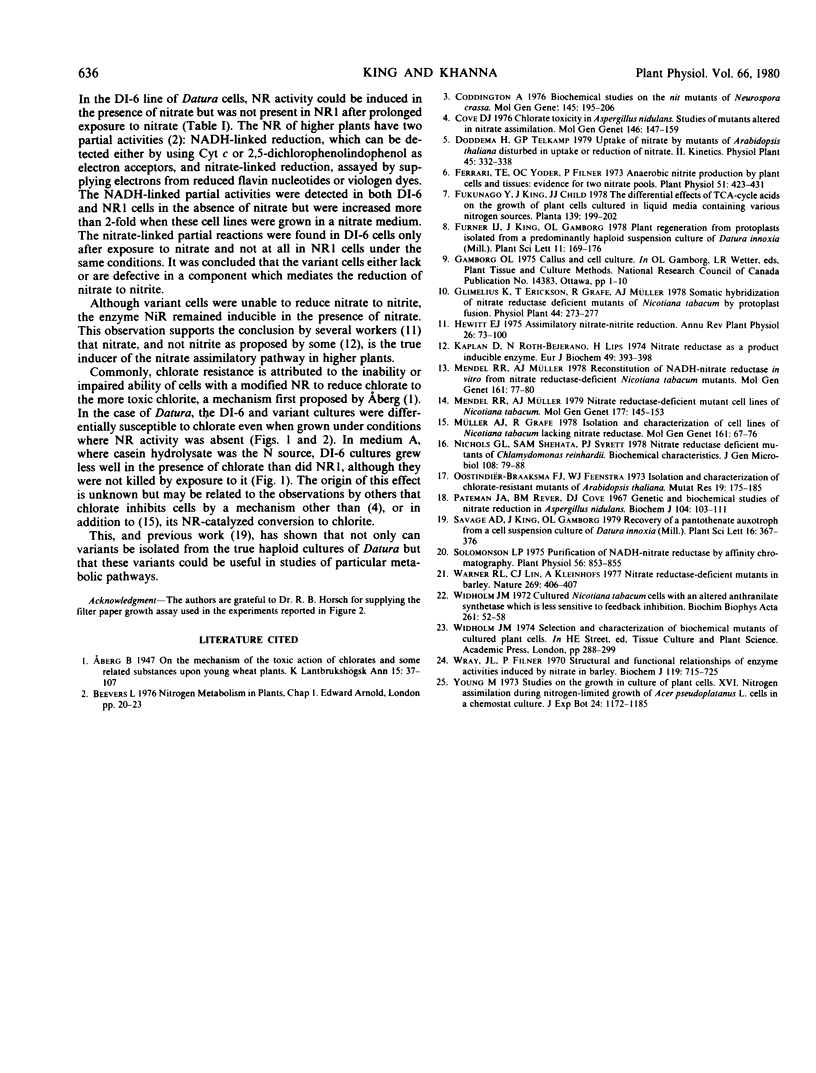Abstract
A comparative study has been carried out of the growth of two lines of Datura innoxia (Mill.) cells, designated DI-6 and NR1, their resistance to chlorate, and their ability to assimilate nitrate in sterile culture. The NR1 cell line was isolated from DI-6 cultures by first growing the latter in a nitrate-based medium for 5 days and then transferring the cells to a medium containing 2 grams liter−1 of casein hydrolysate as the sole N source and 49 millimolar KClO3 for a 6-week incubation period. Cells which survived the chlorate treatment then were transferred to casein hydrolysate medium and have been cultured in the absence of chlorate for more than 18 months (NR1).
DI-6 cells can grow in a nitrate-based medium, whereas NR1 cells can take up nitrate but cannot use it as a N source. The inability of NR1 to assimilate nitrate appears to be due to the lack of an active nitrate reductase in these cells. Through the use of a variety of electron donors and acceptors, the lack of nitrate reductase activity in NR1 cells was shown to be due to the absence of, or a defect in, that component of the enzyme which mediates the reduction of nitrate to nitrite.
In other experiments, DI-6 and NR1 were grown on a solid medium containing casein hydrolysate (2 grams liter−1) as the sole N source. Under these culture conditions, neither cell line contained an active nitrate reductase. The growth on this medium was compared to that on the same medium containing chlorate at concentrations from 0 to 100 millimolar. DI-6 culture growth was inhibited by 70% at a chlorate concentration of 30 micromolar, whereas growth of NR1 was stimulated by more than 60% on the same medium and by 100% at a chlorate concentration of 30 millimolar. In the presence of 100 millimolar chlorate, the growth of both cell lines was completely inhibited. This clear difference between the response of DI-6 and NR1 cells to chlorate even in the absence of nitrate lends support to the observations by others that chlorate inhibits cells by a mechanism other than, or in addition to, its nitrate reductase-catalyzed conversion to chlorite.
Nitrite reductase was induced by nitrate in NR1 cells as well as in DI-6. This observation is a further confirmation of the fact that nitrate, not nitrite, is the true inducer of the nitrate assimilatory pathway in higher plants.
Full text
PDF




Selected References
These references are in PubMed. This may not be the complete list of references from this article.
- Coddington A. Biochemical studies on the nit mutants of Neurospora crassa. Mol Gen Genet. 1976 May 7;145(2):195–206. doi: 10.1007/BF00269594. [DOI] [PubMed] [Google Scholar]
- Cove D. J. Chlorate toxicity in Aspergillus nidulans. Studies of mutants altered in nitrate assimilation. Mol Gen Genet. 1976 Jul 23;146(2):147–159. doi: 10.1007/BF00268083. [DOI] [PubMed] [Google Scholar]
- Ferrari T. E., Yoder O. C., Filner P. Anaerobic nitrite production by plant cells and tissues: evidence for two nitrate pools. Plant Physiol. 1973 Mar;51(3):423–431. doi: 10.1104/pp.51.3.423. [DOI] [PMC free article] [PubMed] [Google Scholar]
- Kaplan D., Rtoh-Bejerano N., Lips H. Nitrate reductase as a product-inducible enzyme. Eur J Biochem. 1974 Nov 15;49(2):392–398. doi: 10.1111/j.1432-1033.1974.tb03844.x. [DOI] [PubMed] [Google Scholar]
- Pateman J. A., Rever B. M., Cove D. J. Genetic and biochemical studies of nitrate reduction in Aspergillus nidulans. Biochem J. 1967 Jul;104(1):103–111. doi: 10.1042/bj1040103. [DOI] [PMC free article] [PubMed] [Google Scholar]
- Solomonson L. P. Purification of NADH-Nitrate Reductase by Affinity Chromatography. Plant Physiol. 1975 Dec;56(6):853–855. doi: 10.1104/pp.56.6.853. [DOI] [PMC free article] [PubMed] [Google Scholar]
- Widholm J. M. Cultured Nicotiana tabacum cells with an altered anthranilate synthetase which is less sensitive to feedback inhibition. Biochim Biophys Acta. 1972 Jan 28;261(1):52–58. doi: 10.1016/0304-4165(72)90312-1. [DOI] [PubMed] [Google Scholar]
- Wray J. L., Filner P. Structural and functional relationships of enzyme activities induced by nitrate in barley. Biochem J. 1970 Oct;119(4):715–725. doi: 10.1042/bj1190715. [DOI] [PMC free article] [PubMed] [Google Scholar]


